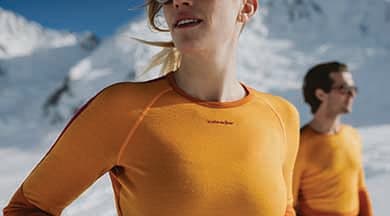How to get started with trail running
March 23, 2023 | icebreaker
Bored with running on the long, dull stretch of a grey treadmill or roads? Trail running opens up the whole world to you – literally! When you trail run, you can get the best of both the running and hiking worlds: physical exercise for a healthy body and time in nature for a healthy mind. And it doesn’t require much more skill or gear than regular road running, so it’s easy to get started. In this guide, we’ll cover everything you need to do your first trail run.
Why trail run?
Trail running benefits both your body and your mind in many ways. It lets you be out in the luscious beauty of nature, explore new terrain and routes, and can even be part of your road running training regimen.
Benefits to the body
Trail running is a fantastic form of physical exercise, but it has some perks that road running misses. You can reap these benefits whether you exclusively run trails or include them with a mix of routes.
● Avoid common injuries. Dirt trails are much softer ground than concrete, so they’ll absorb some of the impact of slamming your feet down. This helps reduce some of the wear and tear on your joints that long-term running can cause.
● Build balance and strength. Trails present a much more variable path, including inclines, declines, switchbacks, and obstacles. These added flavours increase the run’s challenge and force your body to adapt and become more versatile. You must change your rhythm and movements to adjust to the surface, often in a split second. As a result, running trails helps you improve your balance and build strength in muscle groups that get used infrequently or not at all. This will also improve flexibility and help prevent injuries.
● Build stamina. Since trails aren’t flat and smooth like most roads, energy is spent adjusting to terrain changes or reacting to obstacles. Your body may work two or three times harder over the same distance on a trail than on a road. If you add significant elevation or take trips to run at higher altitude, your body will also learn to work with less oxygen. The next time you hit the road, you’ll likely find it easier or faster than before.
Benefits to the mind
It’s a well-known, well-proven fact that time in nature is good for the mind and soul. Trail running can be like yoga for the mind: it requires deep focus, calm, and strength. Many trail runners claim that it’s rather therapeutic. You have to focus so much on the terrain underfoot and on your body’s movements that you cannot be thinking about the stress or problems of daily life.
● Enjoy nature. Trail running is a two-for-one deal: appreciate nature and get your workout in! As you run, you’ll get a lovely view of the outdoors and can gulp lungful’s of fresh, clean air. Keep a steady pace for both stamina and to fully take in the scenery.
● More meditative, less competitive. Runners have often claimed that trail running requires such deep focus on the terrain and every muscle that it becomes meditative. While road running presents a relatively constant path, trails change day by day, hour by hour. The trail can seem new even if you just did it a day ago. Trail running is widely known as the more meditative, solitary sport, while road running is more about racing or training for time.
● Build mental fortitude. Trail running requires intense focus and awareness of both your body and the terrain. The unpredictability of the ground, and the quick changes it requires from your body, mean your mind is just as constantly engaged as your legs. Also, it’s more difficult to simply quit – you’ve come this far into nature, you’ll have to walk or run back. Just like other outdoor activities like biking and backpacking, you may be out and on your own for quite a ways and need to not get freaked out by that. Trails exercise your mind by giving it sudden puzzles to solve very quickly, and by forcing you not to give up. But it’s so worth it! Every completed trail is a huge accomplishment, and a testament to what humans can do when we put our minds and bodies to it.
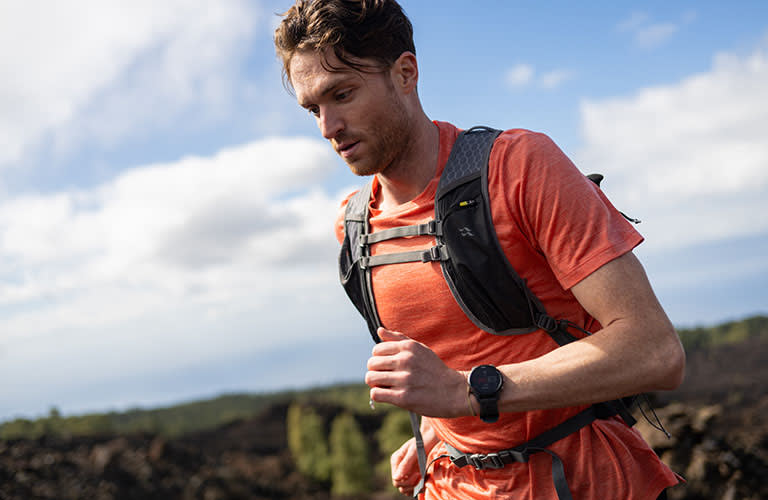
How to get started
Now that you’re excited, here’s how to set off on your first trail run! There are just 5 simple steps to getting started, and you’re likely already semi-prepared. You don’t have to begin at the expert level with professional-grade gear, but there are a few must-haves and must-do’s to have a positive first experience.
Step 1. Find the right shoes
Step 2. Get the right gear
Step 3. Find your trail
Step 4. Train and improve
Step 5. Love trail running!
Step 1. Find your trail running shoes
Trail running shoes are typically heavier than road running shoes since stability, traction, and protection are all critical. If you’re a runner already, you probably have at least one pair of solid running shoes that you could trail run with. Your first run should be fairly mellow, on a gravel road or a groomed dirt path, so you could get by with your usual, all-purpose shoes. But the more you build, the more you’ll want specific trail running shoes.
● Match the terrain. There’s a range of trail running shoes today, matching the range of terrain and trail grades available to run on. You can pick a lighter shoe for short, easier trails; a mid-weight reinforced shoe for longer, rougher trails; all the way to heavy and stabilized shoes for rocky, highly technical terrain.
● Match your feel. You can also choose your shoe based on how you want to feel on the trail: if you want to feel your feet right on the ground or include a cushion to reduce impact. Minimalist trail running shoes will give you a greater feel for the trail and your body’s reaction to it, as well as your fine muscle movements. Maximalist shoes have more cushion to reduce impact and protect your joints, which can be important on high-mile or rougher terrain.
Step 2. Get your trail running gear
When you run trails, you’re at the mercy of the elements. You aren’t going backpacking, but you’ll still need to bring some gear with you to make sure you’re comfortable and prepared for mother nature’s temper.
Clothing
Like most outdoor activities, your trail running clothing should be made of moisture-wicking synthetic materials like merino wool, nylon, or polyester. This includes undies and socks! You likely already have plenty of running clothes and don’t need to get anything new for your first few trails runs.
Since you’re outdoors, you’ll want to check your area ahead of time for any inclement weather or conditions that would require extra clothing. If you’re running somewhere rainy or cool, add a lightweight rain jacket shell or windbreaker.
Layers are highly advisable for trail runners. You may start off sunny and warm at the trailhead, but the environment may change as you move deeper in or higher up. Also, your body will change as you exercise. Warmth and perspiration will change how you feel in your clothing. Make sure all your layers are breathable, moisture-wicking, and lightweight so that as you shed them you can still comfortably carry them on your person. You can find out more on how to layer icebreaker merino in our guide.

Trail running gear checklist
Once you’re dressed, and your laces are tied, here’s our quick and dirty checklist for your running pack:
● High-energy snacks
● Water (with electrolytes)
● Running watch
● Sun protection
● Navigation tools
● Light
Food and water
Eat and drink before your run so that you can start off energized and fuelled. How much water and nutrition you’ll need to carry with you depends on the time and difficulty of your run. If you’re going for a short, easier run, you may only need a single handheld water bottle and energy bar. For longer or more challenging runs, you may want a hydration pack with more storage, multiple energy and food options, and perhaps some electrolyte replacement. Note that in trail running, a “short run” is generally anything less than 60-90 minutes, rather than a certain mileage. Of course, you also must carry your house or car key, some cash, your ID, and any other small necessities (medication, phone, etc.)
● Water. You have several options for water, including hydration packs or vests, handheld water bottles, or waist packs with bottles. As you start out with shorter trail runs, a handheld water bottle or small waist pack should suffice. As you advance to longer runs, a larger waist pack or running hydration vest or pack is preferable since these can also carry extra clothing, food, first aid, and other essentials. For hydration packs, we recommend a slimmer design so that your arms can swing freely and a water pouch with a straw that can be held on a shoulder strap.
● Food. For a shorter run, all you likely need is a couple of energy gels or a protein bar, but for longer runs, you may want more options like bars, gels, and chews. Consider what sits well in your tummy while you’re running and what doesn’t – you can use your road running as a reference for this. For really long runs that may be half- or full-day adventures, heavier foods like peanut butter & jelly sandwiches, trail mix, and such are good options.
Other gear
Trail running is significantly gnarlier than road running, even on beginner terrain, so you need a few more essentials to have a good time. You should start off with well-known, well-marked trails so that you don’t have to worry as much about safety, but it’s still a good idea to be prepared – and start getting familiar with using your new tools.
● Watch. There’s a range of outdoor activity watches, from basic sport watches to high-end smartwatches. Ultimately, it should come down to your needs and comfort. If your watch is too bulky it can throw off your form, and if you’re too worried about it getting damaged, you won’t focus as much on your form and your run. At the most basic, an outdoor GPS watch that is durable and light is a great option, and can provide you with a long battery, tracking, and route guidance. Among those, there are plenty of basic watches or those with lots of other features. Choose what metrics matter most to you – distance, pace, calorie burn, time, heart rate – based on your activity goals.
● Navigation tools. If you’re running in an unfamiliar area or on a less-marked trail, bring navigation tools like a map, compass, and GPS. Many sport watches on the market have route planning and tracking features, so these can double as your navigation tools too. Just don’t rely on your smartphone, since many trails go in and out of signal range.
● Sun protection. We tend to forget about sun exposure when preparing for outdoor activities. Yes, the sun will make your body heat up, but it can also hurt your skin if you’re not careful. Don’t forget sunscreen and lip balm, and you should add a hat and lightweight, sun-protective clothes to your trail running outfit.
● Light. If you like to run later in the day, at dusk or even at night, a headlamp or a small handheld flashlight is important. Trails get dark and difficult to see quickly, especially if you’re in the forest where trees can obscure natural light. Your own provided light will help you be able to still see the details of the terrain, and safely explore.
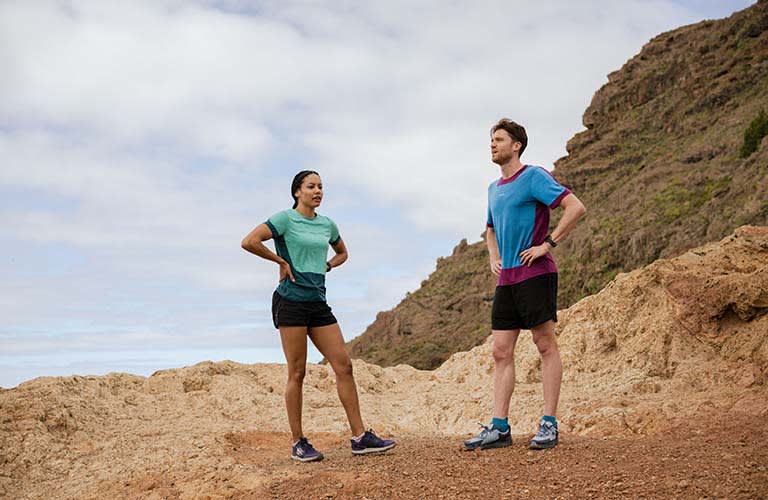
Step 3. Find your running trail
Start with an easy, mellow trail that isn’t too different from your preferred road running specs. Try to find something you’d feel comfortable with: a trail near your area, lower mileage than your usual run, gravel or groomed terrain, or a path you’ve walked before.
● Location. You may want to pick a trailhead that’s close to where you live so that you’re already familiar with the area. If you’d rather make a whole adventure out of it, pick a trailhead that’s a 20-30 minute drive from you. That way, it’s still new and exciting, but you’re still close enough that you won’t feel uncomfortable or lose your motivation to run. Don’t let long travel time sap your energy!
● Distance. Trail running requires a different way of thinking than road running; most importantly, think time, not mileage. For your first trail, choose a route that’s significantly lower mileage than your road runs. You’ll make up for the “lesser” distance in terrain surprises like switchbacks, inclines, and sneaky roots. Make sure you go with plenty of daylight to spare so that you don’t feel rushed or end up running in the dark.
● Terrain. Study the trail before you run it. You don’t have to walk it first since that might detract from the surprise and excitement that will keep you motivated to run, but you should study the area on a map. Understand if you’ll experience an elevation change and over what distance so that you can prepare for inclines and declines. Read any climate reports to be able to prepare your clothing and gear properly. Check if the trail is groomed so that you can minimize how much you’ll be jumping over roots and rocks. Obstacles can be plenty of fun for the experienced trail runner, but they can be stressful for your first time.
There are lots of outdoors and running apps like Strava, AllTrails, and Trail Run Project. You can use these to choose trails based on the specs listed above (and many more) and keep track of your runs. On many of them, you can even add your own reviews and notes, so you can revisit the trails.
Step 4. Train and improve
Now that you’ve done your first trail run, and loved it, keep it up! We have some tips to help build your trail running training schedule. Build your stamina and strength, get a group of running buddies, and become a trail running pro!
Trail running form and technique
The trail terrain presents unique challenges, with common obstacles that test your reactions, speed, and balance. Your trail running form can be very different from your road running form and may take some adjustments you aren’t used to.
For trail running, keep these key tips in mind:
● Look where you’re going. Focus on the trail 10-15 feet in front of you so that you’re aware of obstacles. Try not to focus right on your feet.
● Use your arms. Even if it feels ridiculous, swinging your arms fully while you trail run helps keep your balance and distributes energy throughout your body.
● Keep a short stride. This helps minimize being caught by surprise by obstacles and gives your brain time to take in the terrain and correct your body’s position to cover it. Keep your feet underneath your body, and don’t overstride. Also, light, quick steps will help you be efficient and adjust to grade changes more quickly.
● Be like a goat. Pick the most sure-footed route, and be comfortable shifting your weight to many different points on your feet to adjust to the uneven surface.
● Focus on an upright posture. Throughout the run, you may be tempted to lean or curl your body, but staying straight will keep your breathing steady and protect you from injury.
Build distance
A simple way to improve your running? You guessed it. Run more! In the same way that you might add mileage to a road route, make a goal to periodically add time or mileage to your trail run. Just one more mile per week, or 15-30 more minutes per week, can help you improve cardio and stamina. Plus, the fun of trails is that every extra bit is exciting, new territory.
Work with hills
All runners are familiar with hill intervals, though many don’t consider them the most fun part of training. Almost all trails and trail races will include some type of climb, so having time dedicated to improving will boost your performance.
To practice hill intervals, pick a part of a regular route. Try to find a technical section with a moderate gradient, and practice walking and running up and down it. Typically, a pattern like this is a good starting point for hill interval work:
1. Walk up the hill, run down, 5 times
2. Run up the hill, walk down, 5 times
3. Run up the hill, run down, 5 times
4. Repeat.
Increase your training by building on the number of reps and then moving on to higher and tougher hills.
When you encounter climbs on your trail run:
● Shorten your stride. It should already be under your body, but keep small, frequent steps to maintain your cadence.
● Stay upright. We’re often tempted to lean forward or hunch on uphill’s (or when getting tired), but this reduces the space for your lungs and diaphragm to expand. We’re similarly tempted to lean back and loosen up on downhills, but this can strain your muscles and increase hard impacts on your joints. Stay upright to maintain effective breathing on uphill’s and to preserve your body on downhills.
● Walk if you need to. There’s no shame in protecting your body against a super steep, gnarly climb. Trail running is very much about technical skill and loving the outdoors and less about speed. Better to preserve your muscles and joints so that you can train and improve than to get injured.
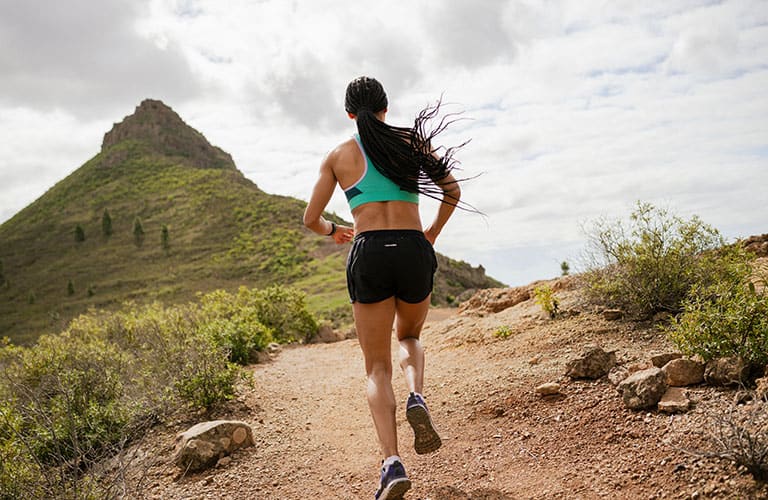
Cross-train
Balance and strength are key on your trail run. The more you improve them, the more enjoyable the run. Many runners of all types incorporate cross-training into their routine since any one exercise every day can wear down your joints and muscles (and get boring). Prepare for harder trail runs through plyometric exercise, a type of training that builds agility, muscle power, and balance through the speed and force of different movements. Exercises like squats, lunges, and box jumps can improve your trail running ability.
Schedules and buddies
Since it’s not always as easily accessible as road running, trail running may be a tough goal some days. It may require travel time, or more prep, or simply greater mental fortitude than you feel like giving. Rest days are necessary, but you can help combat the running lazies with a scheduled routine and with some buddies.
Set a schedule for yourself based on your activity level, goals, and time management. Be realistic – if you work 6 days a week, have children or have other responsibilities, it may be tough to commit to a 3-hour run every day. It’s okay if you can only do so much, so long as you’re getting out there and are happy with your activity.
Early mornings can be a great time since trails are usually quieter and less crowded, and your run can be completed before the rest of your day begins. Some runners prefer evenings after the majority of their day is done, and they can relax after a post-run meal and shower. Incorporate time into your schedule since some days you may have more free time. Also, consider variation in routes, time, and activity type to keep it interesting; you’re less likely to get bored and feel tired if you switch it up.
Finally, find a trail running group or a friend to go with. We’re social creatures, and exercise outdoors with good company can be incredibly beneficial for your physical and mental health. Especially trail running, and as a beginner, a group can help motivate you and make you feel comfortable.
Look on social media or on some trail apps to find groups based on area, skill, or schedule so you can find one that matches you or get a friend who is also interested in getting started trail running. With company, you’re less likely to feel overwhelmed or lost on the trail, can keep a better pace, help each other cover obstacles or face new challenges, and generally make the activity even more fun. Shop icebreaker to gear up for your next outdoor adventure.
More for you
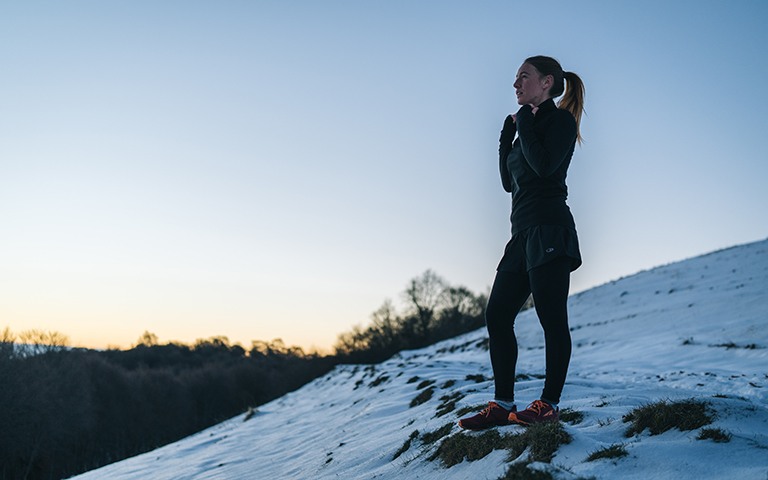
What to wear when winter running? | icebreaker
22nd December, 2022 | icebreaker

How to get motivated for early morning exercise | icebreaker
22 April, 2022 | icebreaker
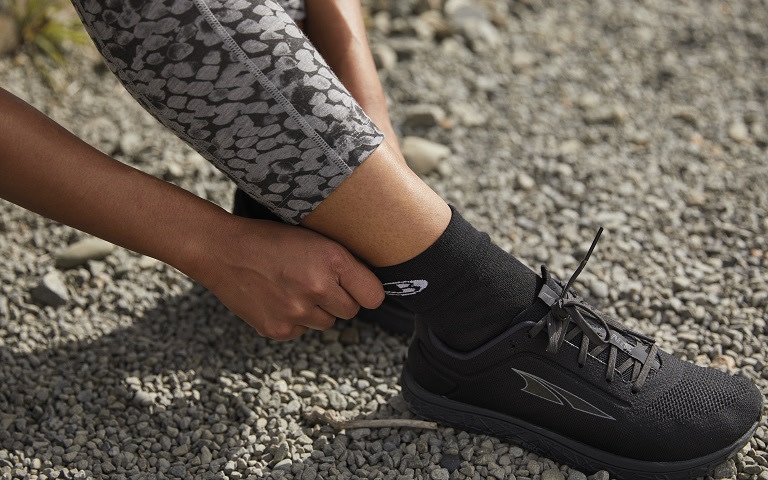
What to look for in running socks | icebreaker
3rd March, 2022 | icebreaker

